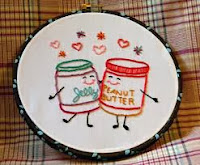 |
| Graphic Source |
Basics
A sandwich made from 2 tablespoons of peanut butter, 1 tablespoon of any flavor of jelly and two slices of white bread has 376 calories, 13 grams of protein and 3.5 grams of dietary fiber. It has 16 grams of total sugar, which is a significant amount considering that the American Heart Association recommends limiting sugar intake to 12 grams daily for children, 20 grams for women and 36 grams for men. Honey has more sugar than jelly, but replace them with half of a small banana and you’ll lose about 6 grams of sugar. If you use whole-wheat bread, you’ll get a little more protein and triple the fiber.Healthy Fats
A classic peanut butter and jelly sandwich has 18 grams of fat. This could be a good chunk of your total daily fat, depending on how many calories you consume. The American Heart Association recommends limiting fat to less than 25 to 35 percent of your total calories. Based on a 2,000-calorie-a-day diet, the fat in one sandwich equals 23 to 32 percent of total calories. But there’s good news. The sandwich doesn’t have any cholesterol, and 80 percent of the total fat consists of healthy unsaturated fats that lower cholesterol. |
| Source |
Vitamins
One sandwich has 20 percent of the recommended daily intake of vitamin E, 27 percent of folate and 42 percent of niacin. Vitamin E is an antioxidant that protects vital lipids in the body from free radical damage. Niacin metabolizes food into energy and helps keep your skin and nervous system healthy. Folate is so essential for the production of DNA and growth of new cells that it prevents birth defects of the brain and spinal cord. It also lowers levels of homocysteine, which helps your heart because high levels are associated with cardiovascular disease.Minerals
You’ll get many of the essential minerals in a peanut butter and jelly sandwich, including 14 percent of the daily intake of calcium and magnesium -- but the sandwich is a better source of iron and zinc. Iron doesn’t just deliver oxygen to cells; it also stores it in muscles so that you have enough during exercise. Zinc is needed to make proteins and new cells. It also helps support your immune system. From one peanut butter and jelly sandwich, men get 30 percent of their daily intake of iron and 12 percent of zinc, while women get 13 percent of their daily iron and 17 percent of zinc. |
| Source |
Conclusion
So the "lowly" PB & J sandwich isn't really so bad for us after all. Add a piece of fresh fruit and a cup of 1% milk, and you have a pretty healthy meal.Who'dathunk?
 |
| (c) Copyright 2014 Robyn King. All Rights Reserved. |
Sources: http://nationalpeanutboard.org/the-facts/fun-facts/
http://healthyeating.sfgate.com/benefits-peanut-butter-jelly-sandwiches-5553.html
Images courtesy of Google Images unless otherwise noted.
(c) Robyn King. All Rights Reserved.